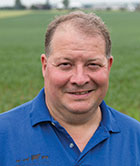
I was in the middle of a right displaced abomasum (RDA) surgery when the lights went off. Yes, it was later than we usually do these procedures, but Dave and his crew had been busy chopping hay and a cow, Number 3578, had been found in trouble when her group was brought in for the evening milking around 7 p.m.
Dave called and apologized, reminding me that I had always followed the rule Dr. Hull had taught that you never let the sun set on an RDA because it can become a torsion and then the cow won’t see sunrise. I told him that I wasn’t upset because he called after supper and before my shower. Of course, he would still pay an emergency fee because I was going to miss the nightcap of the T-ball double header.
Long day lighting
Why did the lights go out at 9:30 p.m. while the herd was still being milked? Milking happens around the clock on many of our dairies, and lighting is pretty important. As you drive around our area at night, the lighted barns look like a fleet of ships.
Many dairies have adopted long day lighting for all of its advantages. Providing 16 to 18 hours of light above 15 foot candles can be even more profitable than 3x milking. They are synergistic together.
We measure the light intensity three feet off the ground at the level of the cow’s eye because the eye is the gateway to the brain. The pineal gland at the base of the brain controls the endocrine response to declining day length from fall to spring. The pineal gland needs at least four hours of darkness to trigger that it is a new day.
Long day lighting can raise milk production in dairy cattle up to 10% within the first 10 days of lactation, showing a 3.7-pound increase. After 20 days, a 6.8-pound improvement has been shown in studies. Long day lighting also slowed the decline in milk production post peak in cows that started their lactations under natural light.
Those levels of production growth can have a pretty rapid payback for the investment required. The difficulty, as usual, is in the details.
Making it work
How do you manage long day lighting on a dairy that is milking around the clock? Light intensity needs to be uniform throughout the barn at 15 to 20 foot candles during the “on” period and less than 5 foot candles during the “off” period. Red lighting can provide enough light to operate safely during the dark period without triggering cows to think that the lights are on. I don’t know that the research has been done on whether the 12 minutes in the parlor will negate the off cycle.
What about the holding pen? Can we run it with red lights? Can we stagger the pens such that every pen can be in the dark for at least four hours and in the light for 16? This might take some thought.
Better lighting has some side benefits as well. It can reduce slips and falls by workers and allow for better observation of cows in heat, cows with health problems, cows that are off feed, and poor feed quality.
Dry cows are responsive to the photoperiod, too, but the effect is the opposite. Short days for dry cows, around eight hours of light, shows a 6 to 7 pound increase in production the following lactation and up to 3 pounds greater dry matter intake (DMI) while still dry. There should be significant health benefits from more DMI.
I think this is going to be hard to achieve during much of the year on most farms, though. We don’t have lights that create darkness, so it may take creativity to make this happen.
Prepubertal heifers are an untapped opportunity for long day lighting. In 1984, I was attending the Student Veterinary Symposium at Michigan State, and I asked Dr H. Allen Tucker to see his long day lighting experiments.
We now spend a lot of time measuring and weighing heifers. As I went from a room with long day lighting to natural lighting, I could visually see improved growth when heifers were on long day lighting.
Research has shown leaner growth, greater mammary development, and lower age to puberty by a month with long day lighting. These heifers partitioned their nutrients to skeletal growth rather than body condition. It was proposed that they were more feed efficient. The long day heifers also had higher milk production for the first five months of lactation.
Let there be light
So, what happened to Number 3578 left standing in the dark during her surgery? After doing thousands of these surgeries, we joke about how we can do them in our sleep or in the dark, but we actually need a few foot candles and our full attention.
My luck is usually good, and Dave came rolling in as the lights went out, saw my truck, and flipped the override switch. I finished the surgery without further incident and the cow went on to do well with over 140 pounds of milk a month later. All is well that ends well, and the cow is fortunate to live on a dairy that works hard to provide for her needs, including her need for light.









